
Guilherme Vaz. A Fraction of the Infinite, 2014. Film still: Daniel Leão
A Fraction of the Infinite
Guilherme Vaz
To Andrei Tarkovsky1
A Fraction of the Infinite is a work of empirical sound art. It also honors Charles Darwin and his travels through Brazil by following the same trail he crossed. It is a small work about a big theme. It is also part of an imaginary anthropological theater and sound cinematography that I am working on: Nocturnal travels about the world of symbols. The piece’s references come from the indigenous world of Brazil: the jungle, universal geometric forms drawn freehand, from people more than objects. The work features seven points of infinity as simple poetry, each one dense like Silence and free like the Wind. Because of this, I see the work as essentially one of contemporary art – there is no “climax”, all points are of equal significance. These are the first points filmed in a series that could go on into infinity, like a never-ending cord of free associations.
Guilherme Vaz. A Fraction of the Infinite, 2014.
The Players: The Indigenous Philosophical World and Nature, Society and The Educator
Three vectors are present:
1) Philosophy and indigenous knowledge, the condition of living in America – with its reality of not accumulating wealth, respect to nature, exploitation, harmonic social life – represented by Rattle # 1 and the actor Guilherme Vaz.
2) Society or the Lady in Black, represented in the film by the actress Jessica Gogan, learns with indigenous philosophy and nature, symbolized by the geometric indigenous-style drawings that she completes. Learning with Rattle # 1 she observes as she draws, noting what she sees, while listening to the indigenous philosophy represented by Rattle # 1 and to nature and the jungle that surrounds her as she passes.
3) The educator and education that substantiate the drawings of the Lady in Black with the sounds of Rattle # 2 represented in the film by the actor Guilherme Vergara.
Plates of Signs and Symbols
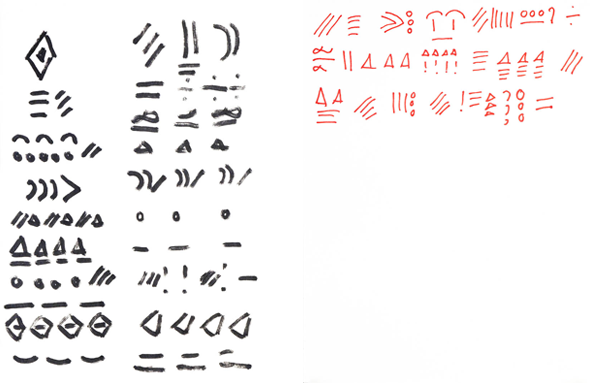
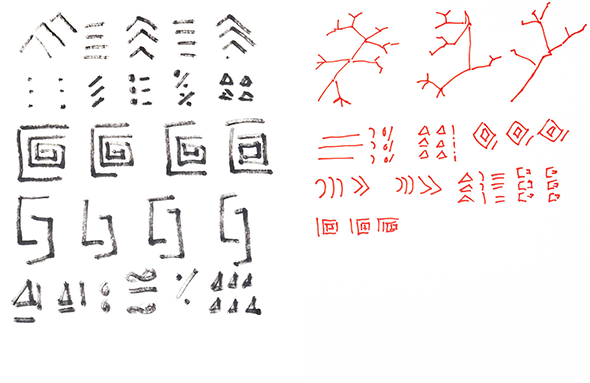
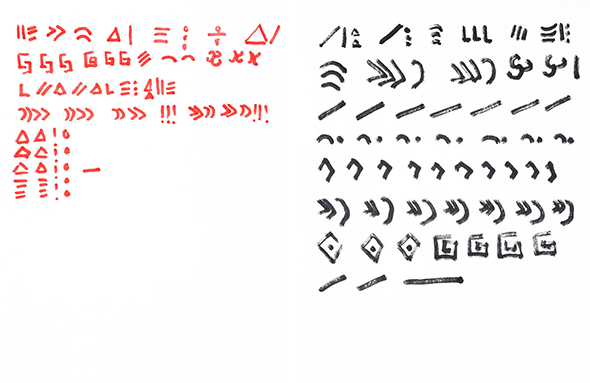

Guilherme Vaz. Plates of Signs and Symbols: A Fraction of the Infinite, 2014. Photos: Rafael Ajordan.
Each plate and sheet of paper filled with signs and symbols impulsively embrace and move each stopping point of sound theater onward with its actors. The plates are annotations, impulses, and unveilings of society represented in the film by the actress in the black dress. Society absorbs the signs of the infinite, while night moves. Each plate is a sign from the sea, a lighthouse, and a fraction of the infinite; they possess a guiding rule all the while appearing entirely freeform, a delicate rule – all language should operate with Amerindian symbols and freehand geometry. Reminiscent of geometric sisters the world over, especially from locales abandoned in time, they exist everywhere in the world. They are graphic markings before writing. But, the written is not always language, as such these markings are pure language, their meaning is unknown or merely pre-meant (felt), this doesn’t matter; their existence embraces the universe we love.
The Lady in Black and Society
The Lady in Black is society. From now on I will always use this icon when I write about society, or think about it. I think that I have come across an almost perfect image – perfect may be too strong a word, but it reflects my thoughts and perceptions about the notion of society. Society as the Lady in Black – in my many travels and all the places that I can think of, including the Amazon, this image pleases me, because there exists words that I don’t know how to express, say, about what I see in society, but the image says what I can’t say by the absence of words. I still don’t have the words. They are not born yet. Black says mystery and Enigma, the unknown, we don’t know what is society yet, and this is good. It’s not bad as one may imagine. This is the infinite, a black dress, nighttime, we are still trying to know: who is society? ……. It is an open work. What is society, we don’t know, let’s try just to perceive it and not invent theories. Another element that I don’t know if one can talk about is that this image is connected to Old William’s Dark Lady Sonnets.2 I often see this image behind the words of these sonnets as I read them, trembling. Another connection is nightfall, when the human imagination frees itself and flies with many nocturnal meanings, sounds and feelings, these free associations define all that I think when I imagine the Lady in Black as society.
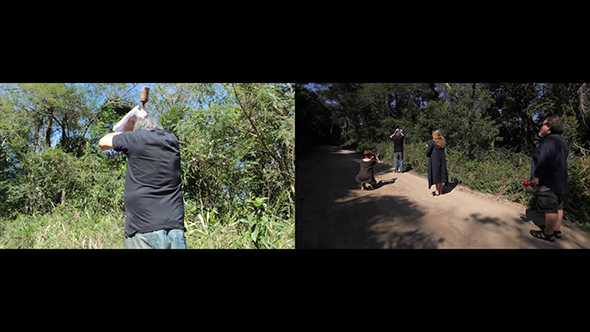
Guilherme Vaz. A Fraction of the Infinite, 2014. Film still: Daniel Leão
Silence
I see today diverse densities and kinds of silence that are entirely distinct. Each one has their own nature depending on the time of day, anthropology, night – these are the diverse personalities of silence – silence is not an abstraction.
Once I said at MAM (Museum of Modern Art, Rio de Janeiro), when presenting the work Crude during Romano’s exhibition, that if sound art is not capable of silence then it cannot be art.3 No one thinks that there should be silence in sound art. One thing is experimental music, another is sound art, the trajectory of both is entirely distinct even with their similarities. In experimental music it is easier to talk of silence and to be understood than with sound art. As most sound artists come from visual art they don’t have a germane understanding of silence connected to sound, but instead have merely this notion as a concept, it is not real yet, and their works continue to be super-saturated with sound without any phenomenological consequence.4
Silence is fasting. No one thinks that there should be silence in sound art. It’s not only the presence of sound that defines a work of sound art, but silence, because when people think about sound they don’t think about silence, but it is not possible not think about it. Silence in sound art is as important as sound, and for this reason there are silences in A Fraction of the Infinite. This clear position is part of the work’s conception, even moments that have the sound of the jungle with almost no volume. There is also the silence of the actors: stopped in the forest, on the road, even with the sound of nature barely inaudible, a dramatic silence is present.
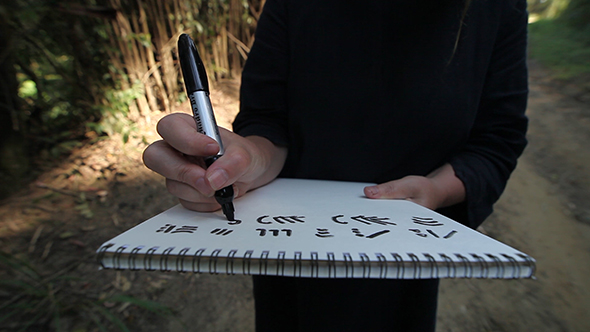
Guilherme Vaz. A Fraction of the Infinite, 2014. Film still: Daniel Leão
Niterói and Darwin’s Trail
Everything in this work has a conceptual element that in turn has a meaning denoted in the smallest of details. The choice of Niterói and not Rio is significant. When I was invited to make a work of sound art for Revista MESA, I thought about it a lot, and considered a number of solutions in Rio, urban ones, but over time I decided to choose Niteroi as a place to extend my reflections. It is not an informal or momentary decision; it is a conceptual and semantic decision; it was necessary to have the presence of the jungle and tradition, the semantics of the forest. This meant Niterói was the best choice. In addition to this, I imagine what might be seen as a line of thinking that relates contemporary art and particularly MAC (Museum of Contemporary Art of Niterói) and the unique and special region of Niterói. The decision of Darwin’s Trail was also made in this vein, in the sense that it symbolized the presence of nature and the environment and art in the world. This doesn’t mean that the work is Darwinist, no, but it suggests that the relation of universal life with all other lives is necessary here, the relation between all living things and all elements of a context. It was this that I imagined when I read Darwin’s proposals, the relation of everything with everything, the relation between all the elements of the universe, of what we call in art, transversality – everything in the world is related, the progress of relational in nature and philosophy, this is the meaning.
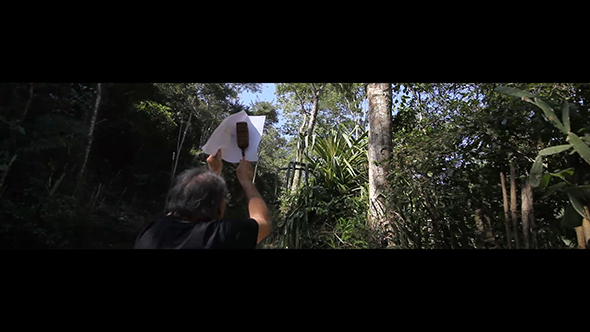
Guilherme Vaz. A Fraction of the Infinite, 2014. Film still: Daniel Leão
The Rattles
The rattles are the principal font of sound. The rattle is the iconic instrument of America, ancient and millenary, and of the indigenous people of America, and it seems to me even North America. In this way it is a sound of both the actual and eternal America, and the sound of the great West – open, it points toward this dimension. Its sound is produced by dry seeds, but it is also for seeds, the sound of the great jungle because seeds are what it plants, the instrument itself plants, plants seeds, this to give an initial idea of the symbolism of this instrument.
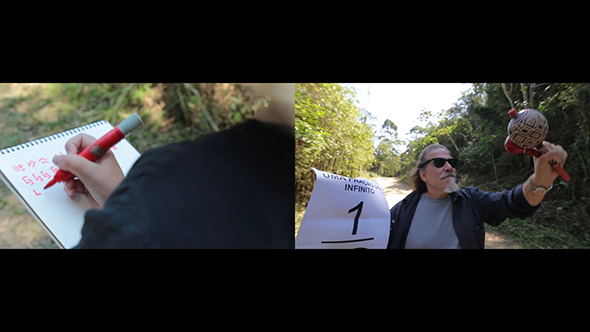
Guilherme Vaz. A Fraction of the Infinite, 2014. Film still: Daniel Leão
The Theater
Why theater and theater in the style of Grotowksy, instead of cinema?5 Because people are present in theater, much more than an object of common visual art peopled by objects. Experimental theatre makes those who are watching feel that it is possible to be part of the scene because there are people on the other side and not just objects. The question of the person/subject, more than the object, is essential in my work, and it cannot be understood without this chronic admiration of the subject, whatever it may be, to such an extent that even the anachronistic object of bad taste has a sense of the sublime when close to the subject. It is so great that it crosses the frontiers of art’s eras and of taste and above all of good taste; it is capable of legitimizing the inexpressible, and the object of the most profound bad taste can become sublime. The person, what philosophy calls the subject, is far and away more important than the object, surpassing it and the angularity of compositional options and of the philosophy of art. For this reason I call this work theater. A Fraction of the Infinite is not an object, a common object as most sound art and visual art, but the passage of the subject with sound over the body of sound art. This is what that theater means in a world where everyone mistakes art with objects.

Guilherme Vaz. A Fraction of the Infinite, 2014. Film still: Daniel Leão
_
1 The Russian film director Andrei Tarkovsky (1932–1986) was one of the most important directors of the 20th century. This work is dedicated to Tarkovsky and the symbolic nakedness so common and dear to all his films – the symbolic world present naked without filters is evoked in my work with the players: society, indigenous philosophy and the educator. The director’s method of speaking, whether in his books or films, fascinates me, because he did not create filters or clouds between the spectator, the creator, the author, the actors and the discourse, making everything very clear, the symbol and its sequence, something that I admire, making the image direct and the invention powerful, vertical – for this I dedicate this work to the Russian director.
2 William Shakespeare (1564–1616) published his collection of 154 sonnets in 1606. The sonnets explore themes of time, love, beauty and mortality. The Dark Lady Sonnets, those numbered 127 to 152 reflect the desire of the poet for a mysterious woman – the word black describes in various moments her beauty and treachery. These multiple meanings in a constant process of change, offer a parallel and innovative way of seeing society.
3 Crude is a sound piece that is essentially about making the walls and floors of museums resonate using the percussion of the palms of one’s hands against the walls. I performed this work first at the 8th Paris Biennial in 1973 and then recently in a contemporary re-working with the Brazilian sound and visual artist Romano (1969- ) at the 7th Mercosul Biennial, Porto Alegre, Brazil, 2009 and again during his exhibition at MAM in 2012.
4 Despite the pioneering legacy of John Cage (1912–1992) and his well-known 4’33”, first performed in 1952, where musicians do nothing aside from being present for the duration of the title, I see that the use of silence still tends to be more conceptual rather than corporal.
5 Jerzy Grotowski (1933–1999) was a Polish theater director and a great innovator of experimental theater, with concepts such as “theater laboratory” and “poor theater.”



